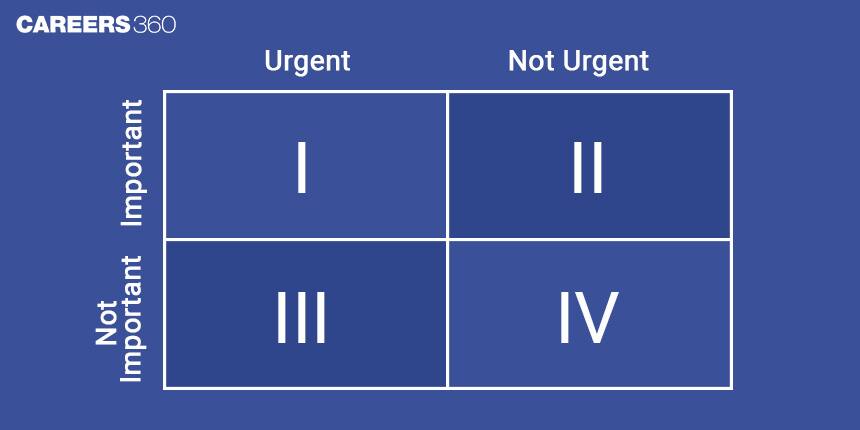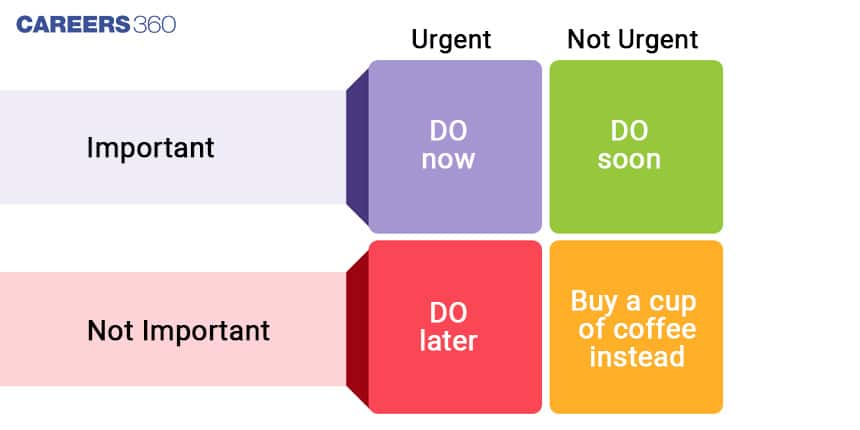Learn How To Prioritise And Manage Time
Think about the activities that you do daily or for a week. Have you ever thought about how much time you spend on them? What are the activities done on priority? Should these activities be noted and prioritised? Or done randomly? If you note and prioritise your daily routine according to the importance and urgency, then you will notice a huge improvement in your time management skills. To help you do this, Careers360 has simplified the famous Eisenhower Priority Matrix that divides tasks based on urgency and importance. Let’s see how you can employ this in your day-to-day study schedule.

Eisenhower Priority Matrix.
The four quadrants of the Eisenhower Priority Matrix are
Important And Urgent
Important And Not Urgent
Not Important And Urgent
Not Important And Not Urgent
 Quadrants Of Eisenhower Priority Matrix
Quadrants Of Eisenhower Priority Matrix
Let us understand the terms associated with the Eisenhower Priority Matrix based from a student's perspective.
Important Tasks
The tasks that contribute to achieving your goal. Usually students' goal may be cracking an exam with a good score or rank. All the activities that help to achieve a score or rank in an exam can be categorised as important.
Some of the important tasks may be-
Planned study- This includes making a plan of studies for a week or month, regular studies, homework, practice test and more
Maintaining your health- That is a good diet, regular exercise and sleep
Unimportant Tasks
The tasks that do not contribute to the goal are unimportant. Some unimportant tasks are-
Using social media for a long time
Watching TV for long duration
Attending unimportant call or online chats
Spending more on unimportant tasks implies that you are not moving towards the goal.
Urgent And Important Task
The quadrant I represents urgent and important tasks. These are the tasks to be done immediately. For example-
Revising or studying for exams to be held in the next day
Working on assignments to be submitted immediately.
Important And Not Urgent Tasks
These are tasks that can be done on a regular basis and that contributes to the goal. For example-
Regular studies
Attending lectures
Exercising regularly
These tasks come under the second quadrant.
Not Important And Urgent Tasks
These are tasks that should be noted urgently but spend small amounts of time on this. For example-
Looking at the mails
Answering important phone calls
These tasks come under the third quadrant.
Not Important And Not Urgent
The tasks on which minimum time should be spent or no time should be spent comes under the fourth quadrant. For example-
Using social media which is a waste of your time.
Watching TV for a long time
Chatting with friends for a long time
These four quadrants can also be represented as-
 Four Quadrants Of Priority Matrix
Four Quadrants Of Priority Matrix
How To Fill The Four Quadrants Of Time Management Matrix
You can fill the quadrants depending on your activities. Now you know what is important, urgent, not important and not urgent. Based on the activities, these matrices may vary for each student. Students can create their own matrix based on their target goal. A sample matrix is given below.
Time Management Matrix Example
Quadrant I
| Quadrant II
|
Quadrant III
| Quadrant IV
|
Reduce your time in quadrants III and IV and spend more time on quadrant II. This will make the quadrant 1 task easier. By spending your time on Quadrant 2 activities you devote time to important activities before they become urgent. Understand your time waster, use a smart study plan to make quadrant 2 effective and achieve your goal easily.
